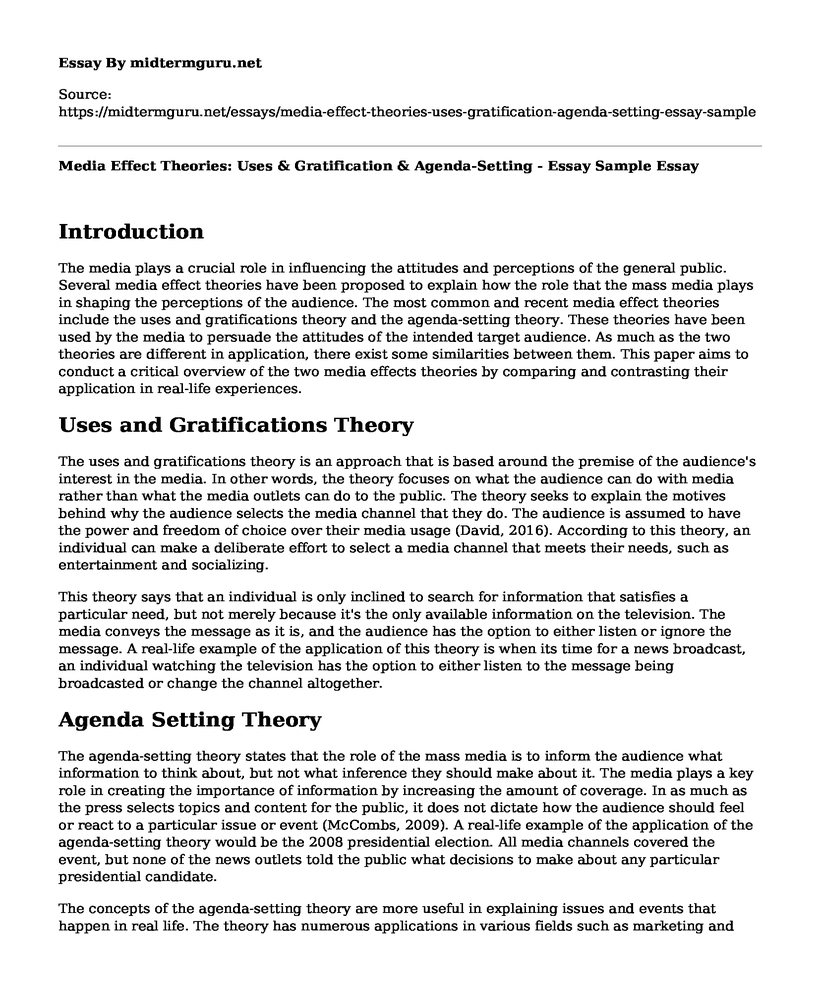Introduction
The media plays a crucial role in influencing the attitudes and perceptions of the general public. Several media effect theories have been proposed to explain how the role that the mass media plays in shaping the perceptions of the audience. The most common and recent media effect theories include the uses and gratifications theory and the agenda-setting theory. These theories have been used by the media to persuade the attitudes of the intended target audience. As much as the two theories are different in application, there exist some similarities between them. This paper aims to conduct a critical overview of the two media effects theories by comparing and contrasting their application in real-life experiences.
Uses and Gratifications Theory
The uses and gratifications theory is an approach that is based around the premise of the audience's interest in the media. In other words, the theory focuses on what the audience can do with media rather than what the media outlets can do to the public. The theory seeks to explain the motives behind why the audience selects the media channel that they do. The audience is assumed to have the power and freedom of choice over their media usage (David, 2016). According to this theory, an individual can make a deliberate effort to select a media channel that meets their needs, such as entertainment and socializing.
This theory says that an individual is only inclined to search for information that satisfies a particular need, but not merely because it's the only available information on the television. The media conveys the message as it is, and the audience has the option to either listen or ignore the message. A real-life example of the application of this theory is when its time for a news broadcast, an individual watching the television has the option to either listen to the message being broadcasted or change the channel altogether.
Agenda Setting Theory
The agenda-setting theory states that the role of the mass media is to inform the audience what information to think about, but not what inference they should make about it. The media plays a key role in creating the importance of information by increasing the amount of coverage. In as much as the press selects topics and content for the public, it does not dictate how the audience should feel or react to a particular issue or event (McCombs, 2009). A real-life example of the application of the agenda-setting theory would be the 2008 presidential election. All media channels covered the event, but none of the news outlets told the public what decisions to make about any particular presidential candidate.
The concepts of the agenda-setting theory are more useful in explaining issues and events that happen in real life. The theory has numerous applications in various fields such as marketing and consumer behavior, advertising, public relations, political campaigns, and mass communication. The media sets the agenda in society through priming and framing. The media uses priming techniques to set the stage for public discussion of specific issues and events. For example, media reporting is strong during the lead up to major sporting events such as the world cup and this creates an interest in the audience for the event. The media, through framing, can use selective control to shape and contextualize issues to influence people's perception.
Contrast Between the Theories
There exists a clear distinction between the two media effect theories, and the differences are quite forthright. In the agenda-setting theory, the audience is mainly exposed to the information and content that the media deems to be important. The audience is usually exposed to the same news headlines from different news channels, and thus, the members of the public are more likely to be familiar with the top stories. In the uses and gratifications theory, the audience has freedom of choice and power over media usage. The public has the freedom to choose the type of information that they seek out to find. This theory gives the audience influence on the media.
Similarities Between the Theories
The similarities between the two media effect theories are evidenced in the choice of the audience. The two theories share a relationship when the audience opts to follow what is being broadcasted by the media. The audience can choose not to change the channel and instead listen to the message being covered. The agenda settings theory is supported because the audience is allowing the media to present the information that it believes to be important. The use and gratifications theory is also supported because the audience has made a deliberate choice to seek out and listen to the information as well.
Conclusion
In conclusion, the paper has provided a critical overview of the two media effects theories. Both communication theories are essential in explaining the role of the media in shaping attitudes and perceptions of the public. The agenda-setting theory seems to be more useful in explaining several real-life issues such as sports, business, and politics. However, the theory may fail to produce the desired effect on an audience that has already made up its mind.
References
David, L. (2016, January 26). Uses and gratification theory. Retrieved from Learning Theories: https://www.learning-theories.com/uses-and-gratification-theory.html
McCombs, M. (2009). AgendaSetting. The Blackwell Encyclopedia of Sociology, 1-2
Cite this page
Media Effect Theories: Uses & Gratification & Agenda-Setting - Essay Sample. (2023, Jan 31). Retrieved from https://midtermguru.com/essays/media-effect-theories-uses-gratification-agenda-setting-essay-sample
If you are the original author of this essay and no longer wish to have it published on the midtermguru.com website, please click below to request its removal:
- Essay on the Influence of Age Exercise Proficiency to Treat ADHD
- Essay Sample on Art and Music as a Caribbean Game Changer
- Articles Analysis Essay on Animal Behavior
- Paper Example on Strategic Therapy
- Movie Analysis Essay on The Wizard of Oz
- Nursing Professionals: Bridging Access to Healthcare for Underserved Communities - Essay Sample
- Politics & Media: United in Existence & Affecting Each Other - Essay Sample







